I was shocked and saddened to learn of the death of Brian Hanna on June 13, 2012 of sudden cardiac arrest. Brian Lowell Hanna was born March 22, 1960 in Minneapolis, attended Reed College, and subsequently received a full scholarship to attend The Juilliard School, Dance Division, in New York City. I worked with Brian in the 1980s, during which period he was a member of my dance company NovAntiqua. He danced with us on tour in France in 1985 and thereafter in New York seasons until 1988, partnering Christine Dakin, Peff Modelski, and Susan Tenney in The Treasure of the City of Women, Antique Scripts, Renaissance Descant, and The Death of an Attitude. He also worked with Debra McCall and Joan Finkelstein who join me here in remembering Brian.
Brian’s performance in Renaissance Constructions could only be described with the French term spirituel: witty, urbane, and graceful. He brought a personal beauty, minimalist directness, creaturely innocence, and irony to his roles. In The Death of an Attitude, based on Tennessee Williams’s Two Character Play, Brian was both comedic and tragic, performing a mental and physical collapse by the end that was dramatically powerful yet achieved in purely dancing terms.
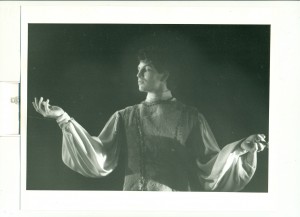
- Brian Hanna in Mark Franko’s Treasure of the City of Women, Montpellier Opera (photo: Véronique Claparède)
I met Brian in 1984 through Debra McCall with whom he was working on Oskar Schlemmer’s Bauhaus Dances; in 1994, I performed with the Company at the Bauhaus in Dessau. Being on tour with Brian was always a delight as his cultural sensitivity, humor, and urbanity were a source of energy and joy. As a dancer he also excelled in Joan Finkelstein’s How I Found Livingstone, which I saw in 1988; additionally, Brian was an understudy in Martha Clarke’s Vienna Lusthaus. As the tributes of Debra McCall and Joan Finkelstein here attest, Brian was a remarkable performer and stage presence, and a warm and beautiful person whose loss creates a void in all of our lives.
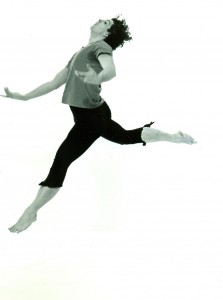
- Brian Hanna in Mark Franko’s The Death of an Attitude (photo: Tom Caravaglia)
Remembering Brian in the Bauhaus Dances
By Debra McCall, Director and Reconstructor, Oskar Schlemmer’s Bauhaus Dances of the 1920s
Brian came to the Bauhaus Dances after we had our inaugural performances at The Kitchen in NYC in 1982. As we were preparing for our first international tour in 1984–eleven cities in the Netherlands; Alabama Halle in Munich in conjunction with an Oskar Schlemmer exhibition; Geneva, Switzerland; and finally, the first International Biennale de la Danse in Lyon, France–Brian proved an indispensable assistant to me for all things that had to be prepared. He also learned the role of the White Figure for Figure in Space.
Figure in Space is a very exacting piece, in which the White Figure must accurately delineate the geometry of the black stage space, Additionally, being the first piece on the program of the Bauhaus Dances, the White Figure set the tone and atmosphere for the entire upcoming spectacle. Brian performed it like no other, before or since. I have seen performers in dance companies in Milwaukee and in Seattle take it on, but no one came close. In fact, the dancer in Seattle, trained at the Peking Opera, said it was the hardest dance he had ever performed, and he was a superlative dancer.
What made Brian’s performance definitive? First, there was his Apollonian physique–like no other, divine in proportion. Sponsors and audience members would ask me “Where did you find him?” as though no such mortal existed. But it was his innate understanding for, and his ability to shape and define space with that physique, that made his performances memorable and classic.
He executed his movements with grace, precision, dignity, and insightful psychological depth, imbuing space with all manner of humanity, from playfulness to humility. He captured the true intention of a moment in history, the 1920s, where the Bauhaus Stage set the bar for experimentation. That is the art of dance, and not many can make the connections between the heart of the matter (body) and external reality (space). Brian was a consummate performer–on stage and in life. As we toured, he was the one who would cheer me up late at night when I struggled with the exigencies of touring in a bus with a six-member company for six weeks!! And he made the funniest jokes–of me searching my purse in a panic for the stash of international currencies we carried along the way–“There she goes, squat and search!” He knew how to twist a moment of anxiety and stress into one of riot.
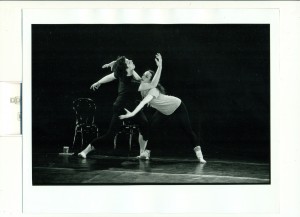
- Brian Hanna and Susan Tenney in Mark Franko’s The Death of an Attitude (photo: Tom Caravaglia
I wasn’t in touch with Brian in past years–work, single parenting and living in eastern Long Island took me from Manhattan. I recall with great respect and affection Brian’s beautiful White Figure moving geometry so perfectly in the black stage space, as well as his unique personal interpretation of Metal Dance. (Excerpts of these can be seen in part on the Bauhaus Dances website www.Bauhaus Dances.org). It is a loss to our dance company and to the dance community at large. But he leaves behind a memorable body of work that deserves tribute.
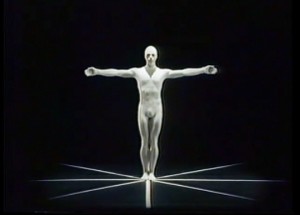
- Brian Hanna in Figure in Space from Debra McCall’s Oskar Schlemmer Bauhaus Dances
Joan Finkelstein Remembers Brian Hanna
I met Brian in 1982 at the University of Illinois in Champaign Urbana. I had come as an artist in residence for a semester, and first saw him in technique class bounding across the floor. His beauty was astonishing, with his classical proportions and beautiful, expressive face. But there was a kind of wildness to his dancing the betrayed a slightly perverse edge and made him exciting to watch. We became friends that spring, dancing together in a concert organized by Ron Sequoio. With the intention of starting a pick-up company back in New York City, I asked him to work with me. Brian became my dancing partner, teaching assistant (at ADF summer of 1987) and muse for the next few years, appearing in the following dances:
How I Found Livingstone (full evening work, 1988)
Hammer Amour (1985)
Berceuse (1985)
Truck Stop (1983)
Descent of Man (1983)
Cutthroat Ties (1982)
Overlap (1982) Advent (1982)
It’s such a shock to lose him, even though we had lost touch for so many years. Out of sight is not out of mind. I will miss knowing that his sardonic wit and artistic take on the world exist.
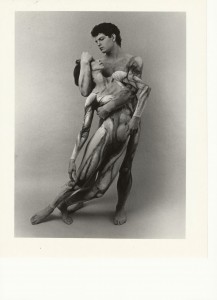
- Brian Hanna and Joan Finkelstein in Joan Finkelstein’s How I Found Livingstone